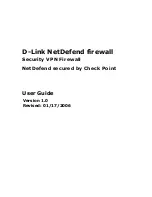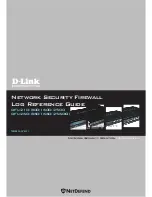
An advisory is a explanatory textual description of a signature. Reading a signature's advisory will
explain to the administrator what the signature will search for. Due to the changing nature of the
signature database, advisories are not included in D-Link documentation but instead, are available
on the D-Link website at:
http://security.dlink.com.tw
Advisories can be found under the "NetDefend IDS" option in the "NetDefend Live" menu.
IDP Signature types
IDP offers three signature types which offer differing levels of certainty with regard to threats:
•
Intrusion Protection Signatures (IPS) - These are highly accurate and a match is almost
certainly an indicator of a threat. Using the Protect action is recommended. These signatures
can detect administrative actions and security scanners.
•
Intrusion Detection Signatures (IDS) - These can detect events that may be intrusions- They
have lower accuracy than IPS and may give some false positives so that's recommended that the
Audit action is initially used before deciding to use Protect.
•
Policy Signatures - These detect different types of application traffic. They can be used to block
certain applications such as file sharing applications and instant messaging.
6.5.6. IDP Signature Groups
Using Groups
Usually, several lines of attacks exist for a specific protocol, and it is best to search for all of them at
the same time when analyzing network traffic. To do this, signatures related to a particular protocol
are grouped together. For example, all signatures that refer to the FTP protocol form a group. It is
best to specify a group that relates to the traffic being searched than be concerned about individual
signatures. For performance purposes, the aim should be to have NetDefendOS search data using the
least possible number of signatures.
Specifying Signature Groups
IDP Signature Groups fall into a three level hierarchical structure. The top level of this hierarchy is
the signature Type, the second level the Category and the third level the Sub-Category. The
signature group called POLICY_DB_MSSQL illustrates this principle where Policy is the Type,
DB is the Category and MSSQL is the Sub-Category. These 3 signature components are explained
below:
1. Signature Group Type
The group type is one of the values IDS, IPS or Policy. These types are explained above.
2. Signature Group Category
This second level of naming describes the type of application or protocol. Examples are:
•
BACKUP
•
DB
•
DNS
•
FTP
6.5.6. IDP Signature Groups
Chapter 6. Security Mechanisms
326
Summary of Contents for NetDefend DFL-260E
Page 27: ...1 3 NetDefendOS State Engine Packet Flow Chapter 1 NetDefendOS Overview 27...
Page 79: ...2 7 3 Restore to Factory Defaults Chapter 2 Management and Maintenance 79...
Page 146: ...3 9 DNS Chapter 3 Fundamentals 146...
Page 227: ...4 7 5 Advanced Settings for Transparent Mode Chapter 4 Routing 227...
Page 241: ...5 4 IP Pools Chapter 5 DHCP Services 241...
Page 339: ...6 7 Blacklisting Hosts and Networks Chapter 6 Security Mechanisms 339...
Page 360: ...7 4 7 SAT and FwdFast Rules Chapter 7 Address Translation 360...
Page 382: ...8 3 Customizing HTML Pages Chapter 8 User Authentication 382...
Page 386: ...The TLS ALG 9 1 5 The TLS Alternative for VPN Chapter 9 VPN 386...
Page 439: ...Figure 9 3 PPTP Client Usage 9 5 4 PPTP L2TP Clients Chapter 9 VPN 439...
Page 450: ...9 7 6 Specific Symptoms Chapter 9 VPN 450...
Page 488: ...10 4 6 Setting Up SLB_SAT Rules Chapter 10 Traffic Management 488...
Page 503: ...11 6 HA Advanced Settings Chapter 11 High Availability 503...
Page 510: ...12 3 5 Limitations Chapter 12 ZoneDefense 510...
Page 533: ...13 9 Miscellaneous Settings Chapter 13 Advanced Settings 533...
















































